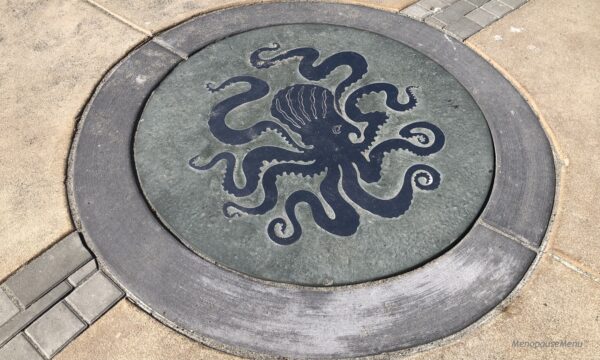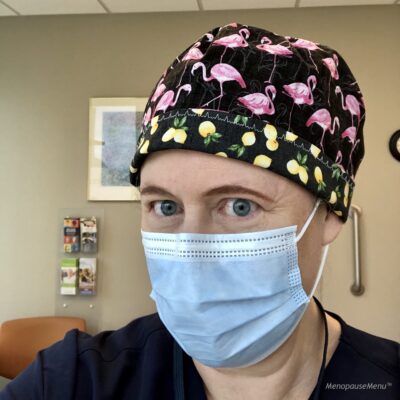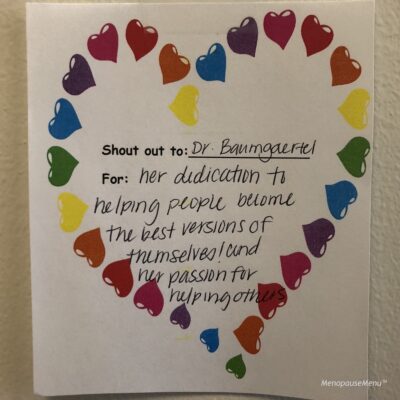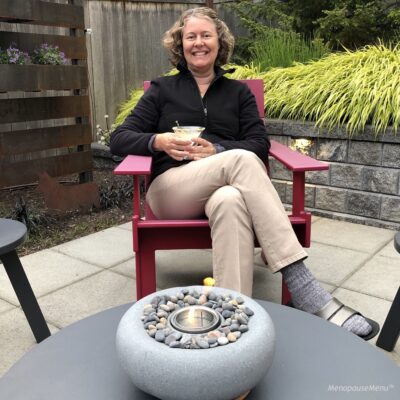Looking back to May of 2021 when this was first posted, it feels like more than a decade has passed. Yet, it has not even been quite two years. The sentiments are still valid, but the journey has now become joyful and filled with new opportunities. See end note for Dr. Baumgaertel’s new career direction.
Editor’s note: I wrote this essay not with the menopausal journey in mind, but it most certainly can be taken in that context because for many, the menopausal time period is often when life changes abound and wisdom prevails. I hope you enjoy reading my personal story.
Many of us can think back (way back) to high school chemistry class when we first learned what a catalyst was – and also what not to do with a Bunsen burner. I prefer to use the second listed definition in the Merriam-Webster dictionary: “an agent that provokes or speeds significant change or action.” I like that it contains the word cat.
The business world’s analogy is “tipping point” which seems to me more foreboding or even ominous – something is about to fall or get damaged…like a cat tipping over a glass of water onto the kitchen floor below.
The implication is of a process that is irreversible; yet a catalyst is neither bad nor good. It can be lifesaving or hasten death. In effect, it is an oxymoron of sorts. At least that’s how I see it now, reflecting back on my life journey since the COVID-19 pandemic began.
It is important to know that a catalyst of any sort is never acting in isolation. As in a science experiment it is just one of many parts needed to get to the end result, often culminating in a faster and more definitive outcome.
This is exactly what happened to me.
I have faced adversity my entire career leading up to medical training (4 years of medical school plus 3 years of residency) and even before that (5 years with a college degree in Architecture & Urban Planning). If you do the math, that’s 12 years beyond grade 13 (yes, I went to high school in Canada) equaling a grand total of 25 years before even starting day #1 in my medical profession.
25 years later I literally walked away from my full-time career in outpatient primary care Internal Medicine. Just last month. Just like that. I must say, on the surface there is something lovely about the apparent symmetry of it all.

The truth of the matter is that there is no symmetry. The last 15 months have been the most difficult ever. As most of the world knows, the Seattle area was considered to be “Ground Zero” in the US for the beginning of the pandemic. So, we’ve been at it the longest and it clearly shows in individual stories.
I do not mean to compare to other places much harder hit or with more deaths or less support, nor do I even for a moment mean to diminish any professional who spent every working hour in the midst of chaos and despair – you know who you are (physicians, nurses, para-professionals, nurse practitioners, physician assistants, respiratory therapists, medical social workers, first responders, janitors and the like) – I admire all of you.
My story is lesser known yet just as poignant, but in a different way. While the nation’s focus was on inpatient, my world was outpatient. Lay press and media all heralded the heroes working in the ER, ICU and COVID units. Funny, but none of the physicians I know felt like heroes…far from it (heroes wear capes, and many were struggling just to find PPE on a daily basis).
Outpatient Internal Medicine quickly became a ghost town as patients didn’t want to come into the office, rightly so because of fears about personal safety, not to mention newly enforced quarantine regulations put forth by our state’s forward-thinking health department at our governor’s decree.
I got sick March 13, 2020 (Friday the 13th, no less) and didn’t physically go back into my office until June 1st, quickly becoming the Queen of Telemedicine – technically, I didn’t even miss a day of work. Early testing for COVID-19 was negative, so I never really knew why I got sick. My sense of smell is still not normal over one year later.
On June 1st, 5 days after the murder of George Floyd, Seattle erupted in city-wide street marches and our clinic shut down early each day that week to protect staff and patients alike. My patients who had waited to see me in-person were thwarted, yet again.
Watching downtown Seattle get destroyed by opportunistic anarchists was surreal, to say the least. I drove home each day through the chaos – it was almost unbearable. On one occasion I pulled over and took a picture of block after block boarded-up with plywood, businesses no longer recognizable. I cried, for so very many reasons.

My office became ultra-focused on seeing patients safely. I suited-up with PPE even when not seeing sick patients due to my own immunosuppressed status and the paucity of any data relevant to my own personal health risks. This pandemic was learn-as-you-go, for sure. Each week, advice on self-protection changed. So, too, advice on how to treat and manage sick patients. Death became more frequent, conversations with distraught family members the norm.
Yet the “heroes” were still in the ERs, ICUs and COVID units. Those of us in outpatient medicine felt forgotten. Corporate declarations of “we are all in this together” and “we support everyone” fell flat. PPE was not always easy to come by. I had to enforce my own PPE rules to feel more prepared, at the risk of looking like I was “overdoing it.” Better alive than dead, in my book. I constantly worried about my staff and my family.
But I am not even really yet addressing why it was so difficult practicing in outpatient primary care Internal Medicine. To be blunt: many patients became fearful, anxious, desperate, angry, and some were downright hostile, rude and toxic to me and to my staff. It got worse as the pandemic progressed. It never really resolved.
First came the “I need a prescription for oxygen.” Oh boy, you are a sucker if you believe Dr. Oz…Dr. Google didn’t go to medical school…my jokes fell flat, and I stopped making jokes. Then I started getting demands for “I need an Rx for N-95 masks, I can’t find them anywhere.” Well, I couldn’t either…not to mention toilet paper, hah!
Soon, the more serious requests were flooding in for hydroxychloroquine. Oh my, all the requests! It did remind me of folks stockpiling Cipro during the Anthrax scare back in 2001. Gee, now that we know of the new “black box” warnings about Cipro (Achilles tendon rupture) I’ll bet nobody stockpiles Cipro anymore. Never mind that hydroxychloroquine has major side effects too…
At the same time there was an uptick in requests for Z-Pak prescriptions. Nope. Sorry. Not going to send it to your pharmacy. What, wait, now I’m not kind and not caring? Then came specific requests for remdesivir (still experimental at that time) and dexamethasone (same). Sheesh…so much for those insulting patient satisfaction surveys that always made me feel like a kitchen appliance.
Then a small “scientific” study leaked to the lay press about blood type being a possible important determinant in whether or not someone could be at higher risk for getting COVID or dying from COVID. This was not presented to the general public in any suitable format so, of course, chaos ensued. I’ve lost track of the requests “What is my blood type?” from patients who were then angry to find out I had never had a reason to check their blood type previously (guess what – insurance won’t cover testing unless you are having major surgery). My advice was to go donate blood and you’ll get to learn your blood type for free. Some did not like my advice. At all.
The antibody testing…oh, my, the antibody testing! This was almost the worst. It always paralleled the questions about family “pods” and whether or not it was safe to visit a family member. I’m talking about COVID antibody testing in 2020, not the 2021 questions about spike protein antibody testing (which is still not fully understood).

Which all leads to the concept of how to give advice in a pandemic. It turns out that almost everyone wanted free care. Well, here in the US, that is currently not happening (I’m not making a political comment, just a reality comment). So, most of these requests FOR THE PAST YEAR were via telephone or messages in our electronic patient portal. Some patients scheduled Telemedicine visits, and a few came in-person, but my 15 hour work days were nothing like I’d ever seen before.
Here is a tip: never begin or end or include in an electronic patient portal message to your physician “Have you read this article?” – link included – referencing something found in the lay press or some obscure scientific publication (as if I don’t read at least 30 articles daily on COVID-19 from world-wide credible scientific sources and communicate in high-level scientific and public health groups on social media 24/7)…nope, not going to read your article. Sorry, not sorry.
I digress. I’ve lost track of how many mask questions I had to answer, most often in-person. These discussions often started with me saying “Please put your mask back on and please cover your nose this time.” Honestly, I’m going to be in this tiny room with you for the next 45+ minutes, very close, often touching you as I examine you…you really do need to wear your mask. Please.
After decades in full time outpatient practice, I learned what a “terminal room clean” means…common knowledge in hospitals, of course.
Then came the first vaccines. Hallelujah! Readily available locally for the hospital medical crew, I had to drive 22 miles to get my first and second Moderna shots. I am not complaining – the drive was actually quite nice since I hadn’t gone anywhere in one year anyway, hah! Little did I know what I was in for related to the ten-fold increase in patient questions…more anxious, more angry, more demanding. It was a blow to my already shell-shocked system. It was like experiencing the Hunger Games. For four straight months.
Intertwined with the vaccine rollout nightmare was the return (did they ever really leave?) of questions about masks, travel, antibody testing, booster shots, Shingrix shots (why were all the local pharmacies promoting the shingles vaccines to literally everyone?), allergy symptoms (because it’s Spring and everyone in Seattle gets allergy symptoms), COVID exposures, school-age kid risks, pregnancies, putting off preventive care, scheduling long-overdue preventive care, mammograms, colonoscopies, hospice care, prescription refills, rashes, depression, abdominal pain, chest pain, cough, orthopedic injuries, fractures, menopause, dementia, cardiovascular disease, cancer…wait, that’s what I do for a living!
What I did for a living.
I resigned.
Looking back, I think I had two (three?) weeks of vacation since March of 2020. I lost a close medical school friend (ER physician) to suicide last August. My mother-in-law died in September. My father just passed in March. Many patients died. I never took time off. Now is that time.

I have spent most of my career ministering to patients and discussing self-care. I never use the word “wellness” anymore (that word has been forever ruined by corporate healthcare). Even self-care is becoming overused, in my opinion. We need to focus more on time: time for sleep, time for nourishment, time for movement, time for being lazy, time for being creative, time for family, time for work.
Time to stop watching the clock.
I resigned, not retired. The best is yet to come.
: : :
End Note: Dr. Baumgaertel now serves patients and clients in her own telemedicine business, myMDadvocate in Seattle, Washington.